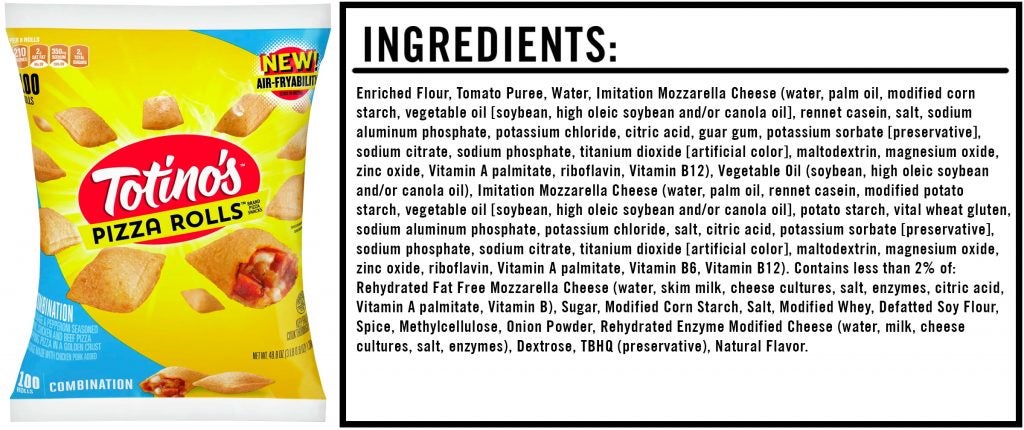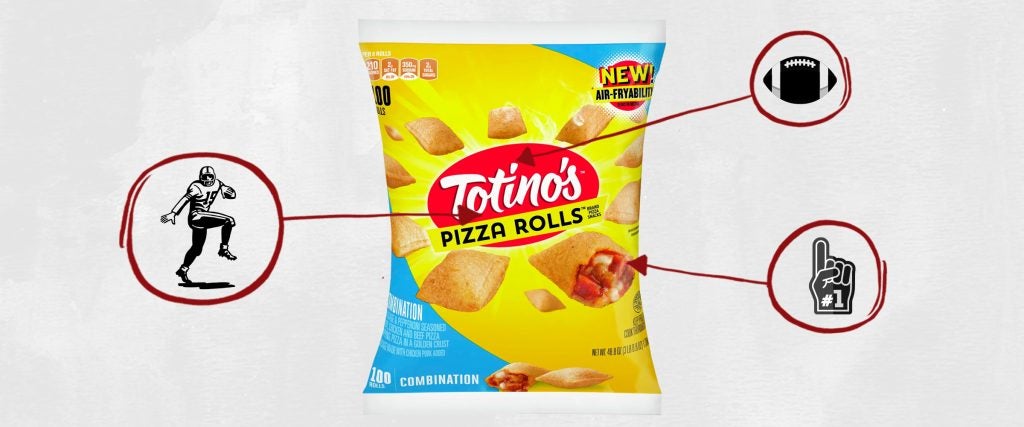Forget Thanksgiving. The most gluttonous day of the year is Super Bowl Sunday, where bowl after bowl and paper plate after paper plate is filled with finger-food bacchanalia that would make even the mad genius responsible for the TGI Friday’s appetizer selection blush (and certainly the ancient Romans). And so, all week leading up to game day, we’ll be offering up our own menu of scientific investigations, origin stories and majestic feats of snacking that not even the biggest sporting event of the year can top. Read all of the stories here.
The way I’ve got it figured, Totino’s Pizza Rolls are what you keep on hand when you need a low-cost alternative to a pizza in a form that’s easily split amongst several friends. This also makes them an ideal snacking companion for a game as consequential as the Super Bowl, because you’re only 12 minutes of oven time away from another round to 10.
So what is contained within these pizza rolls that you’re likely to pop like proverbial pills during the most prominent professional portrayal of pigskin preeminence? (Yes, alliteration is kinda my thing.) Let’s take a peek between its crusty, doughy hood and have a look-see.

Ingredients
General
Enriched Flour: Flour with certain ingredients added back to it, usually comprising the vitamin B complex and iron lost during the preparation process.
Tomato Puree: Tomatoes that have been boiled, mashed and blended.
Water: The foundation of all hydration.
Pepperoni Seasoned Pork: Pig meat, with seasoning added to it. Pepperoni seasonings can vary widely in their ingredients, but its signature heat and flavor typically incorporates paprika, red pepper, black pepper, garlic and some form of mustard.
Vegetable Oil: Since this is the U.S. we’re talking about, “vegetable oil” refers specifically to soybean oil.
Chicken and Beef Pizza Topping
Pork: Shockingly, the foremost ingredient in the chicken and beef pizza topping is additional pig meat.
Mechanically Separated Chicken: Chicken that’s been mechanically deboned, which results in it being altered into a paste-like form.
Water: More hydration in your pizza roll.
Soy Protein Isolate: Refined protein that’s been isolated from the soybean, and the go-to protein supplement of many vegetarians and vegans.
Beef: So curious that there’s more pork, water and soy than authentic cow meat in a chicken-and-beef topping.
Salt: The six-roll serving size only has 380 milligrams of sodium, which is surprisingly low considering a single medium slice of Domino’s pepperoni pizza has twice this amount.
Spices: A proprietary blend of plant-based food flavorings that legally can’t include any vegetables or fruits that can typically stand alone as food items, like onion, lemon or garlic.
Dextrose: A form of sugar extracted from either corn or wheat that’s very similar to the composition of blood glucose.
Oleoresin of Paprika: A semi-solid paprika extract composed of resin and oil. This is used to add flavoring or aroma to food.
Sodium Ascorbate: A mineral salt that has the added benefit of regulating the acidity of the food it’s added to.
Garlic Powder: The dehydrated garlic that you expect from a pizza product.
Natural Flavor: Flavoring that captures the essence of the food that it’s extracted from, which in this case is probably the essence of beef — they have to make up for the shortfall somehow.
Maltodextrin: A starchy preservative powder added to food to improve its texture and lengthen its shelf life.
Sodium Nitrite: A common preservative in meat, like hot dogs, beef jerky and salami. Be careful not to overindulge in nitrates, as consuming high quantities of them has been linked to leukemia, non-Hodgkin’s lymphoma, heart disease and ovarian, stomach, esophageal, pancreatic and thyroid cancers.
Lactic Acid Starter Culture: Not a starter kit, but a form of healthy bacteria used in the production and preservation of fermented foods.
BHA: This is added to edible fats for its antioxidant properties, and is also added to cosmetic products to help reduce fine lines and wrinkles. If you don’t like the taste, just rub it on your face.
BHT: A food preservative that’s also used to treat genital herpes. If you don’t like the taste, just rub it on your… never mind.
Citric Acid: Extracted from citrus fruits and used to give foods a tart, sour taste.
Imitation Mozzarella Cheese
Water: Keeping the moistness potential of the “cheese” intact.
Palm Oil: Edible oil from the oil palm tree. This stuff is used in more than half of consumed American products, including cosmetics, soaps and detergents.
Modified Corn Starch: The dried starch from corn added to improve the texture of food.
Vegetable Oil: A dash of soybean oil.
Rennet Casein: A milk protein often added to cheese to improve its ability to melt.
Salt: More sodium.
Sodium Aluminum Phosphate: Often added to baking powders and cheeses to improve their ability to rise.
Potassium Chloride: This was initially used as a medicine to aid people with low potassium levels, but it’s also now used to boost the potassium content of processed foods.
Citric Acid: More of that naturally occurring fruit acid.
Guar Gum: A vegetable-based gum used to thicken and stabilize food.
Potassium Sorbate [Preservative]: Prolongs the shelf life of food and inhibits the growth of mold.
Sodium Citrate: An alkalizing agent used to neutralize excess acid.
Sodium Phosphate: A food thickener that balances the pH levels of food. It’s also prescribed in larger doses as a laxative to intentionally induce diarrhea.
Titanium Dioxide [Artificial Color]: An inorganic compound often used as a food coloring.
Maltodextrin: More shelf-life-lengthening powder.
Magnesium Oxide: Often used to treat indigestion and constipation. These pizza rolls have built-in mechanisms to offset their side effects!
Zinc Oxide: Added to many foods to fortify them with zinc.
Vitamin A Palmitate: An antioxidant form of vitamin A added to replace the vitamin A lost during milk fat removal.
Riboflavin: Also known as vitamin B2, this is part of the vitamin B complex that promotes a wide variety of cellular benefits in your body.
Vitamin B12: Another vitamin B complex member
Contains Less Than 2 Percent Of…
Modified Corn Starch: More texture improvement powder.
Rehydrated Fat Free Mozzarella Cheese: The dehydrated, rehydrated cheese made from the milk of an Italian buffalo.
Sugar: More sugar in such low quantities that it doesn’t even show up on the nutrition chart.
Salt: Additional sodium.
Modified Whey: The byproduct of the manufacturing of cheese, and the most popular protein supplement on earth.
Defatted Soy Flour: Just as the name suggests, this is a fat-free soy flour that’s also high in protein.
Soybean Oil: Literal vegetable oil. I’m not sure why it needs different names on the same label.
Dried Onion: Dehydrated onion.
Spice: More dried byproducts of uncommonly eaten plants.
Methylcellulose: This chemical compound derived from cellulose is an interesting dual-threat product that’s intended to thicken food and replicate the texture of meat, yet doubles as a bulk-forming laxative.
Rehydrated Enzyme Modified Cheese: This is cheese that’s been specially treated with enzymes to enhance its cheesy flavor.
Dextrose: More specialized sugar that imitates blood glucose.
Maltodextrin: More shelf-life-lengthening powder.
TBHQ (Preservative): This preservative prevents fat oxidation, thereby preventing the food from turning rancid.
Natural Flavor: More essences of real foods.
The Verdict
For the life of me, I have no idea why you’d want to do this to yourself. Who picks a pizza roll over an authentic pizza if they have to choose between the two? I suppose scoring 100 rolls for $10 or less is a bargain, but if we do the math on this, you’d have to drop 48 pizza rolls down your gullet to approximate an entire eight-slice pepperoni pizza. If you figure a pizza slice disappears in five bites or less, you take eight more overall bites to make the same amount of food disappear.
Of course, we haven’t even factored in the rest of the pizza roll’s composition or ingredients — to be honest, I had difficulty surmounting the fact that these things contain not one, but two medical laxatives masquerading as either digestion aids or texturizers. It’s one thing if my food delivers a natural punch to my colon and induces a bowel movement — like a banana — but when my pizza substitute comes pre-infused with its own Dulcolax equivalent, that’s where I check out.

